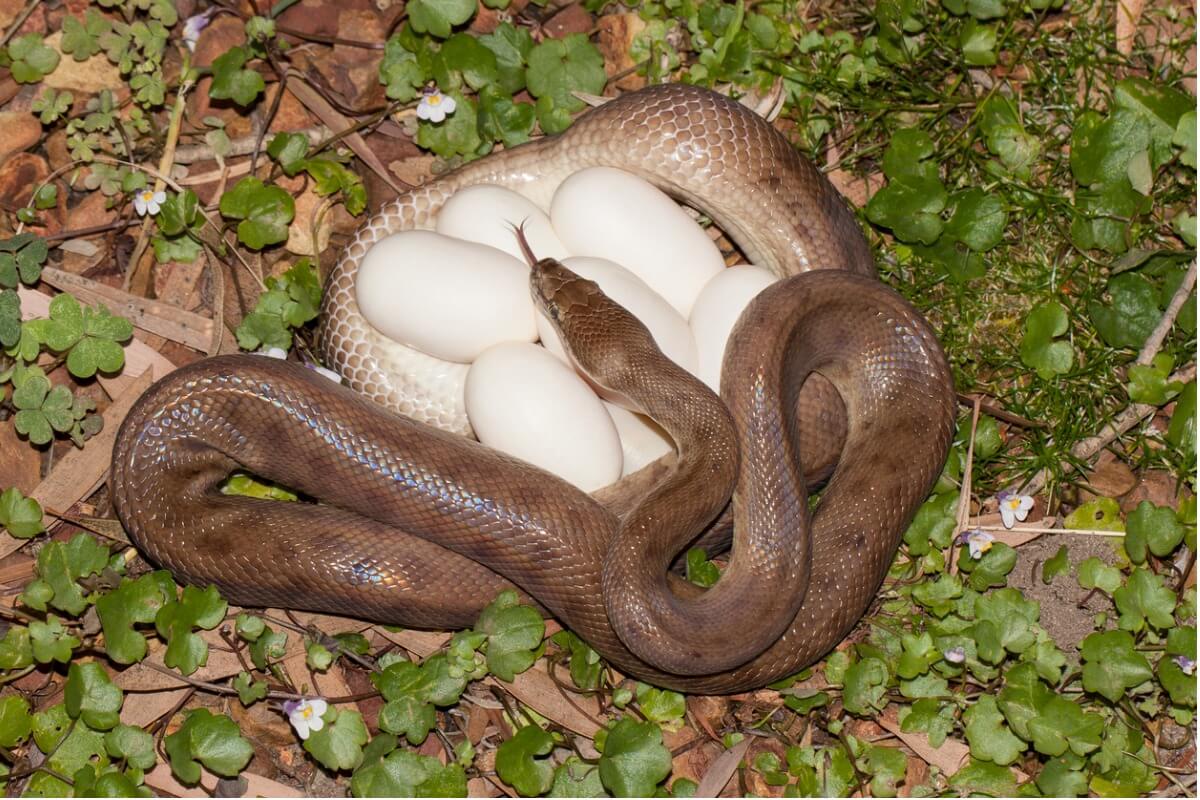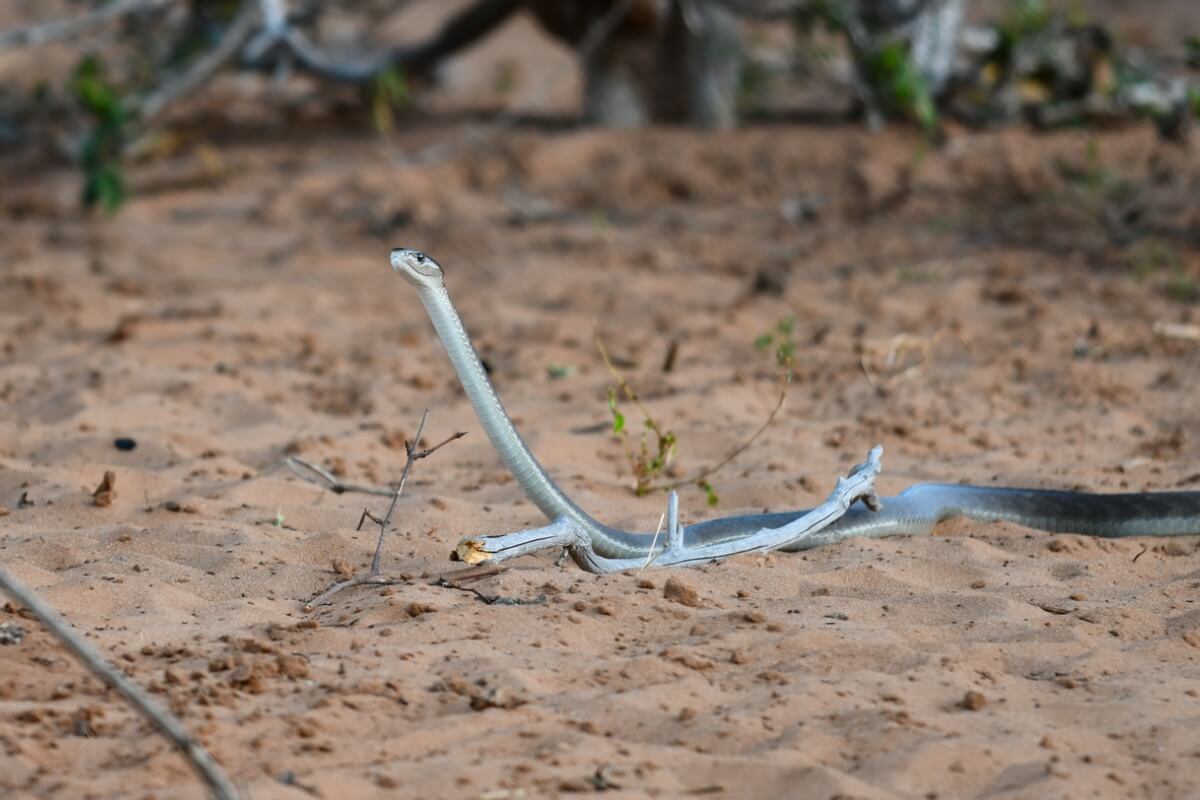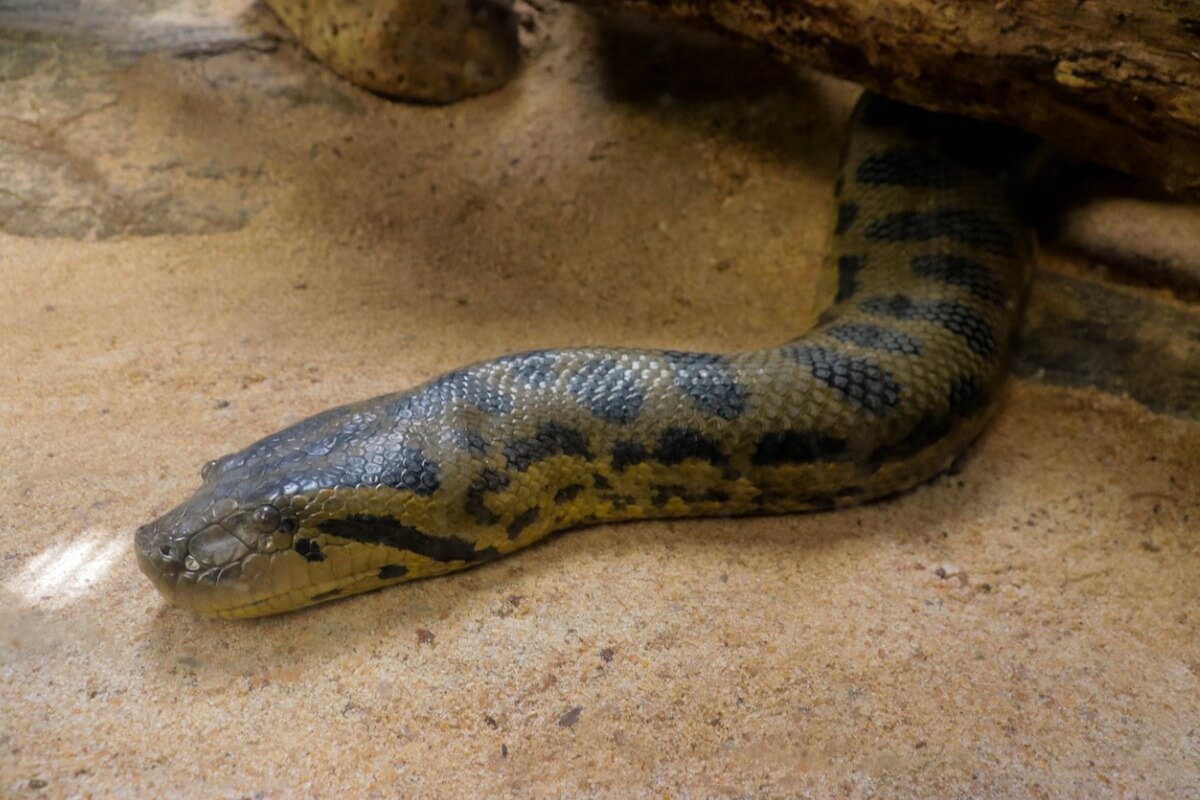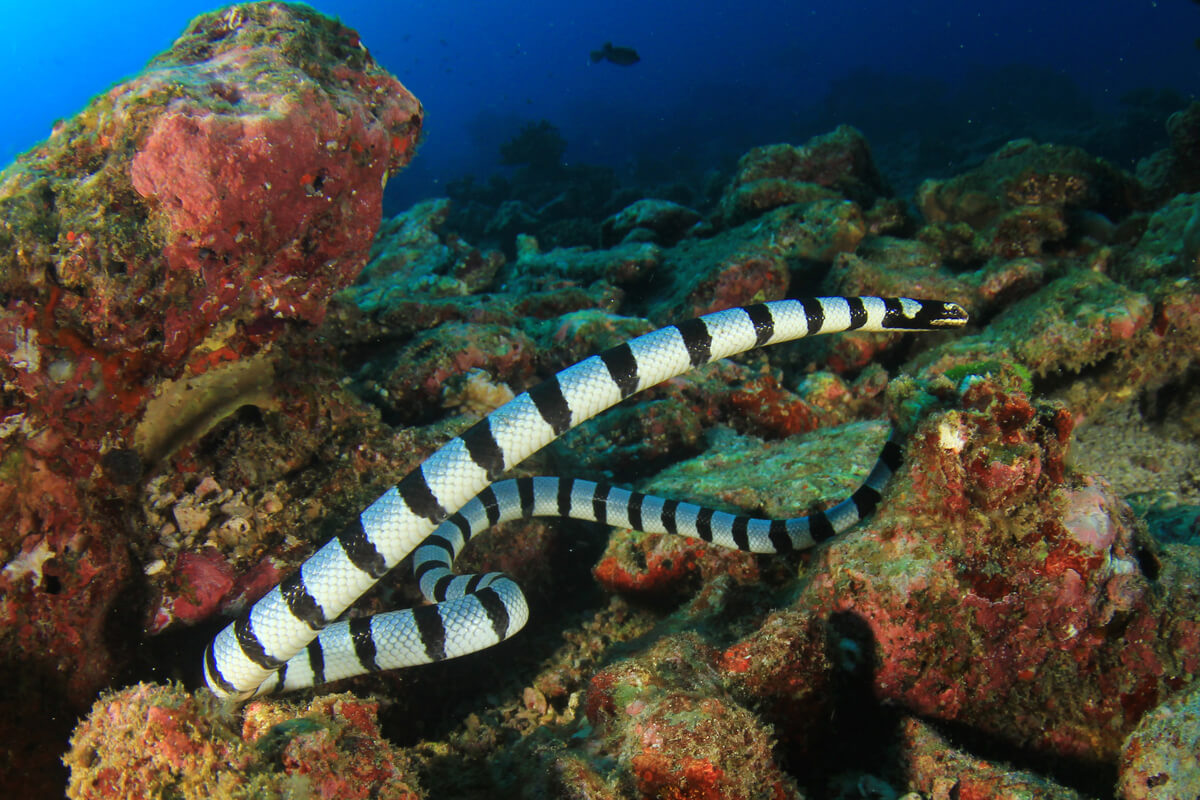How Snakes Are Born


Written and verified by the biologist Cesar Paul Gonzalez Gonzalez
Snakes are well known for their elongated bodies, their poisonous fangs, and their particular way of moving. In addition to this, their form of reproduction isn’t as evident as in other animals, and it’s complex to define if they’re oviparous or viviparous with the naked eye. Due to this, in order to know how snakes are born it’s necessary to delve a little into the biological makeup of these reptiles.
Although their bodies don’t have any limbs, these animals are capable of swimming, diving, climbing, digging and even jumping. The secrets of all their abilities are found in their body, which is so complex that they even have different ways of reproducing. Read on to find out more!
Reproduction of snakes
Like most reptiles, snakes also use reproductive organs to copulate with each other. To do this, males usually have two hemipenes located on the belly just at the base of the tail. At first glance they aren’t obvious, because, while they’re not used, they’re hidden in a type of sack.
These organs behave almost like a human penis, as they also become firm when they fill with blood. In this way, they emerge from their “sacks” to enter the female’s cloaca. For its part, the female uses her cloaca as an entrance to her ovaries, so fertilization occurs in this place.
Male snakes only use one of their hemipenes during copulation but both are useful to them, as it makes it easier for them to mate on either side of the female. In addition, in the case of species that perform mating groups, this characteristic allows them to have a greater advantage during the process.

How are snakes born?
Snakes have adapted to occupy numerous habitats, because, thanks to the fact that their skin prevents them from losing moisture, they’re able to live in arid environments. This independence allowed them to explore various places to nest and helps them settle in new areas. For this reason, a diversification in survival strategies was also caused, which even modified their types of reproduction.
In this sense, these reptiles usually give birth after copulation, although sometimes the females retain the sperm for a time. This allows them to ensure that their offspring will have the right incubation site or that the female will have no problems during delivery. However, depending on the species, snakes are capable of any one of the 3 typical types of reproduction.
Oviparous snakes
The specimens that have this type of reproduction deposit their eggs in a cluster, in which they’ll finish their development thanks to the protection of the shell. These eggs are generally hardy, white, and soft to the touch. In addition, they store inside all the nutrients that the embryo will need for its development (in the yolk).
How many eggs does a snake lay?
The number of eggs varies depending on the species, being the minimum 1 and the maximum 100, but with averages between 2 and 16 per laying. Incubation times range from days to a few months and temperature is an important factor, as it encourages its development. For hatching, the small hatchlings produce a temporary cephalic tooth that only serves to hatch.
Viviparous snakes
Although this reproductive mechanism is very common in mammals, not many snakes have it. This is because, in the habitats in which these reptiles live, it isn’t usually advantageous for a specimen to “carry” its children in its belly, as it carries risks.
Viviparous organisms are characterized by the retention of the young within the mother’s womb, where it feeds directly through a placenta. This exchange of nutrients takes place thanks to the circulation of blood between the mother and her child. On the other hand, deliveries usually last between 1 and 5 hours, with a different number of young in each species.
Ovoviviparous snakes
Ovoviviparous species have an intermediate mechanism that is between viviparity and oviparity. Due to this situation, although the female produces a fertilized egg, it retains it inside until it’s fully developed. In fact, during this process there’s no direct contact between mother and child, since the necessary nutrients are found inside the egg.
This condition seems to be an adaptation to climatic conditions and the hostility of the environment, since it increases the survival success of the young. Thanks to this, the children are safe until the moment of delivery, although fewer of them are born than if they developed as eggs outside.
Types of snakes and how they’re born
The great diversity of reproductive methods that these reptiles have makes it difficult to fully explain each adaptation. For this reason, some types of snakes and the particularities of each one need to be listed separately.
Mambas (Dendroaspis)
These are oviparous specimens with the capacity to produce between 9 and 14 eggs per laying. These snakes have incubation times of 85 days with young that are between 40 and 50 centimeters (16 and 20 inches) long. In fact, at 5 days of age, neonates can already feed on small rodents, so they grow very fast thanks to their diet.

Cobras (Naja)
Cobras are oviparous organisms that lay between 9 and 32 eggs per season. Incubation times take between 38 and 103 days, depending on the temperature in their surroundings. In addition, the female usually makes a second clutch even though the first still hasn’t hatched. After being born, the tiny cobras will consume their first piece of food within the initial 27 days of life.

Genus Vipera
This group includes the snout viper of the Iberian peninsula (Vipera aspis) and the middle eastern horned viper (Vipera latastei). These snakes are viviparous organisms that give birth to up to 20 young at a time, although the average is only between 5 and 9. The incubation periods are usually long and span from 80 to 113 days, varying due to the climatic condition of the environment.

Anacondas (Eunectes)
These large snakes are ovoviviparous organisms capable of producing between 20 and 50 young per parturition. For their mating, they make breeding groups (mating balls) in which a large number of males surround the female to fertilize her. The gestation of these reptiles lasts approximately 6 months, giving birth to young that are 1 meter (3.3 feet) in length.
Although sexual reproduction is the preferred mechanism, the green anaconda (Eunectes murinus) is capable of reproducing by parthenogenesis. In other words, the female doesn’t need a male to get pregnant.

Sea snakes (Laticauda)
These organisms are semi-aquatic beings that, even though they live a large part of their life in the sea, they return to land to mate. The specimens of this genus are oviparous and reproduce by means of groups or mating balls. In each laying, the females lay between 1 and 10 eggs and use earth, caves or crevices as a nest to protect them.

Snakes have conquered most habitats, which has led to their great diversity and adaptation mechanisms. It’s true that several of them are dangerous to humans, but their bad reputation isn’t justified at all. These animals are fascinating enough, despite their lethality and venom, and we hope you’ve enjoyed finding out how snakes are born.
Snakes are well known for their elongated bodies, their poisonous fangs, and their particular way of moving. In addition to this, their form of reproduction isn’t as evident as in other animals, and it’s complex to define if they’re oviparous or viviparous with the naked eye. Due to this, in order to know how snakes are born it’s necessary to delve a little into the biological makeup of these reptiles.
Although their bodies don’t have any limbs, these animals are capable of swimming, diving, climbing, digging and even jumping. The secrets of all their abilities are found in their body, which is so complex that they even have different ways of reproducing. Read on to find out more!
Reproduction of snakes
Like most reptiles, snakes also use reproductive organs to copulate with each other. To do this, males usually have two hemipenes located on the belly just at the base of the tail. At first glance they aren’t obvious, because, while they’re not used, they’re hidden in a type of sack.
These organs behave almost like a human penis, as they also become firm when they fill with blood. In this way, they emerge from their “sacks” to enter the female’s cloaca. For its part, the female uses her cloaca as an entrance to her ovaries, so fertilization occurs in this place.
Male snakes only use one of their hemipenes during copulation but both are useful to them, as it makes it easier for them to mate on either side of the female. In addition, in the case of species that perform mating groups, this characteristic allows them to have a greater advantage during the process.

How are snakes born?
Snakes have adapted to occupy numerous habitats, because, thanks to the fact that their skin prevents them from losing moisture, they’re able to live in arid environments. This independence allowed them to explore various places to nest and helps them settle in new areas. For this reason, a diversification in survival strategies was also caused, which even modified their types of reproduction.
In this sense, these reptiles usually give birth after copulation, although sometimes the females retain the sperm for a time. This allows them to ensure that their offspring will have the right incubation site or that the female will have no problems during delivery. However, depending on the species, snakes are capable of any one of the 3 typical types of reproduction.
Oviparous snakes
The specimens that have this type of reproduction deposit their eggs in a cluster, in which they’ll finish their development thanks to the protection of the shell. These eggs are generally hardy, white, and soft to the touch. In addition, they store inside all the nutrients that the embryo will need for its development (in the yolk).
How many eggs does a snake lay?
The number of eggs varies depending on the species, being the minimum 1 and the maximum 100, but with averages between 2 and 16 per laying. Incubation times range from days to a few months and temperature is an important factor, as it encourages its development. For hatching, the small hatchlings produce a temporary cephalic tooth that only serves to hatch.
Viviparous snakes
Although this reproductive mechanism is very common in mammals, not many snakes have it. This is because, in the habitats in which these reptiles live, it isn’t usually advantageous for a specimen to “carry” its children in its belly, as it carries risks.
Viviparous organisms are characterized by the retention of the young within the mother’s womb, where it feeds directly through a placenta. This exchange of nutrients takes place thanks to the circulation of blood between the mother and her child. On the other hand, deliveries usually last between 1 and 5 hours, with a different number of young in each species.
Ovoviviparous snakes
Ovoviviparous species have an intermediate mechanism that is between viviparity and oviparity. Due to this situation, although the female produces a fertilized egg, it retains it inside until it’s fully developed. In fact, during this process there’s no direct contact between mother and child, since the necessary nutrients are found inside the egg.
This condition seems to be an adaptation to climatic conditions and the hostility of the environment, since it increases the survival success of the young. Thanks to this, the children are safe until the moment of delivery, although fewer of them are born than if they developed as eggs outside.
Types of snakes and how they’re born
The great diversity of reproductive methods that these reptiles have makes it difficult to fully explain each adaptation. For this reason, some types of snakes and the particularities of each one need to be listed separately.
Mambas (Dendroaspis)
These are oviparous specimens with the capacity to produce between 9 and 14 eggs per laying. These snakes have incubation times of 85 days with young that are between 40 and 50 centimeters (16 and 20 inches) long. In fact, at 5 days of age, neonates can already feed on small rodents, so they grow very fast thanks to their diet.

Cobras (Naja)
Cobras are oviparous organisms that lay between 9 and 32 eggs per season. Incubation times take between 38 and 103 days, depending on the temperature in their surroundings. In addition, the female usually makes a second clutch even though the first still hasn’t hatched. After being born, the tiny cobras will consume their first piece of food within the initial 27 days of life.

Genus Vipera
This group includes the snout viper of the Iberian peninsula (Vipera aspis) and the middle eastern horned viper (Vipera latastei). These snakes are viviparous organisms that give birth to up to 20 young at a time, although the average is only between 5 and 9. The incubation periods are usually long and span from 80 to 113 days, varying due to the climatic condition of the environment.

Anacondas (Eunectes)
These large snakes are ovoviviparous organisms capable of producing between 20 and 50 young per parturition. For their mating, they make breeding groups (mating balls) in which a large number of males surround the female to fertilize her. The gestation of these reptiles lasts approximately 6 months, giving birth to young that are 1 meter (3.3 feet) in length.
Although sexual reproduction is the preferred mechanism, the green anaconda (Eunectes murinus) is capable of reproducing by parthenogenesis. In other words, the female doesn’t need a male to get pregnant.

Sea snakes (Laticauda)
These organisms are semi-aquatic beings that, even though they live a large part of their life in the sea, they return to land to mate. The specimens of this genus are oviparous and reproduce by means of groups or mating balls. In each laying, the females lay between 1 and 10 eggs and use earth, caves or crevices as a nest to protect them.

Snakes have conquered most habitats, which has led to their great diversity and adaptation mechanisms. It’s true that several of them are dangerous to humans, but their bad reputation isn’t justified at all. These animals are fascinating enough, despite their lethality and venom, and we hope you’ve enjoyed finding out how snakes are born.
All cited sources were thoroughly reviewed by our team to ensure their quality, reliability, currency, and validity. The bibliography of this article was considered reliable and of academic or scientific accuracy.
- Shibata, H., Sakata, S., Hirano, Y., Nitasaka, E., & Sakabe, A. (2017). Facultative parthenogenesis validated by DNA analyses in the green anaconda (Eunectes murinus). PloS one, 12(12), e0189654.
- Hernández Cordero, A. (2019) Serpientes: atención y cuidados en cautiverio. Tesis de Licenciatura. Universidad Autónoma del Estado de México, Estado de México.
- Lynch, J. D., Sierra, T. A., & Gómez, F. J. R. (2014). Programa nacional para la conservación de las serpientes presentes en Colombia. Ministerio de Ambiente y Desarrollo Sostenible.
- Cuadrado, M. (2002). Sistemas de apareamiento en reptiles: una revisión. Revista Española de Herpetología, 2002, 61-69.
- Melero Jurado, A., Perucho Raventós, S., & Reyes Caballero, R. (2011). Tenencia de serpientes venenosas el vacío legal. Deontología y veterinaria legal.
- LÓPEZ, S. M., GIRAUDO, A. R., Arzamendia, V., & Chiaraviglio, M. (2009). Biología reproductiva de la serpiente semiacuática Liophis semiaureus (Serpentes, Colubridae) en el nordeste de Argentina. Revista chilena de historia natural, 82(2), 233-244.
- Shine, R., Langkilde, T., & Mason, R. T. (2003). Confusion within ‘mating balls’ of garter snakes: does misdirected courtship impose selection on male tactics?. Animal Behaviour, 66(6), 1011-1017.
This text is provided for informational purposes only and does not replace consultation with a professional. If in doubt, consult your specialist.








